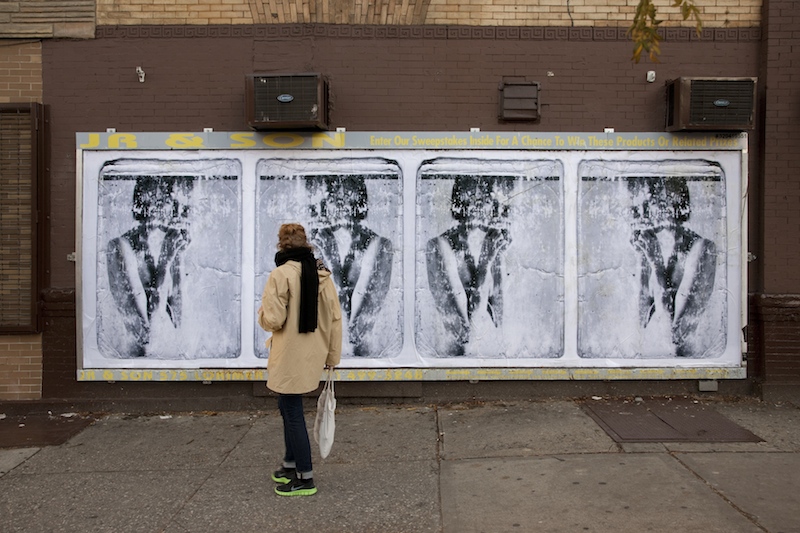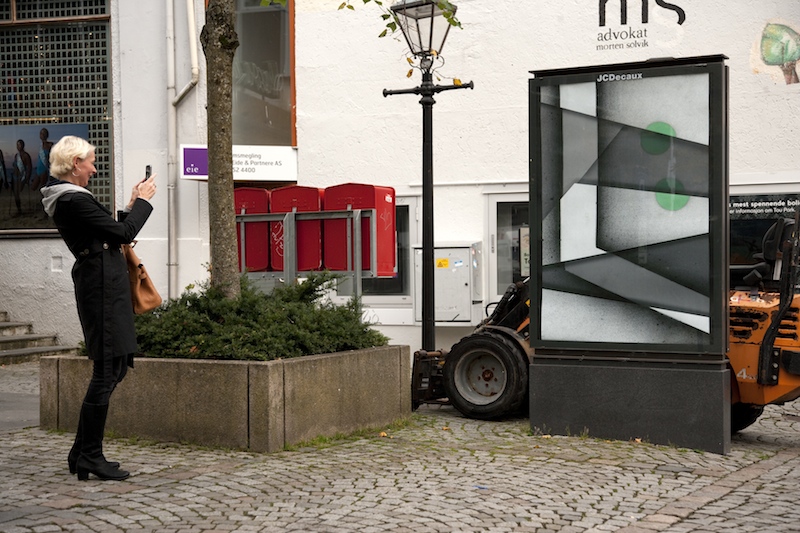
An ad takeover by Jordan Seiler for his “Iselin” series in 2013. Photo by Jordan Seiler.
Jordan Seiler’s PublicAdCampaign blog spreads the word about activism against public advertising by showcasing not just Seiler’s own work but also the work of artists like OX and everyday people doing ad takeovers around the world. Photographs of ad takeovers stay online indefinitely as both documentation of what he or another artist has done and a call-to-action for new activists to start replacing ads with art wherever they are. The posts on the PublicAdCampaign blog allow ad takeovers to break free of both the geographic and temporal constraints that activists reclaiming advertising space have faced for decades.

An ad takeover by Jordan Seiler in Stavanger, Norway for the Nuart festival in 2012. Photo by Jordan Seiler.
Much like how seeing the work of Caledonia Curry aka Swoon and others on the streets of New York City and online inspired more artists to try making large linoblock prints to wheatpaste, showing people that ad takeovers happen seems to have spurred on more ad takeovers. Except that a Swoon wheatpaste lasts for months on the street, whereas takeovers might only last a few hours. For this reason, the internet has been even more essential for spreading ad takeovers than it was for spreading the Block Partier style. I can’t prove that the number of ad takeovers going up today is more than it was 15 years ago, but Seiler says that he gets emails regularly from people asking him how to reclaim advertising space or telling him that they have tried to takeover advertisements after seeing other people try it. It seems a safe bet to say that without Seiler’s PublicAdCampaign blog, many of those people writing to him would not have ever thought to takeover an advertising space.
One example of how Seiler’s blogging has inspired action is the Madrid Street Advertising Takeover (MaSAT). The project was organized largely online by Seiler in cooperation with artists and activists in Madrid. MaSAT came about because Neko (one of two local organizers of MaSAT) reached out via email after seeing other takeovers that Seiler had a hand in. Neko wanted to try something similar in Madrid. According to Seiler, “That probably would not have happened via phone call or some other older technology because they would not have been able to witness visually [the New York Street Advertising Takeover] and decide that that was something that they wanted to bring to their city.”
With MaSAT, the internet also placed a crucial role in the creation of the artwork and the viral distribution of photos of the installed project. Over 100 people submitted text-based content to the project that was then printed out at bus-shelter ad size and installed in Madrid. Most of the contributors were not in Madrid for the takeover, and contributions were solicited via email. My own contribution to the project was even tweaked when some of the volunteers suggested a slight edit, which Seiler told me about via email from Madrid while I was in the USA. Once the pieces were installed, MaSAT naturally had over 100 people ready to share the results and photographs that were posted on the MaSAT website. Ron English’s contribution spoke directly to this point. It simply said “You are not here” (for which the MaSAT website provided translations in Spanish and French), and it was right. MaSAT was organized largely over the internet for the people of Madrid, but also for an online audience that might be inspired to take further action. English’s piece might just as well have said, “You can do this in your city too.”